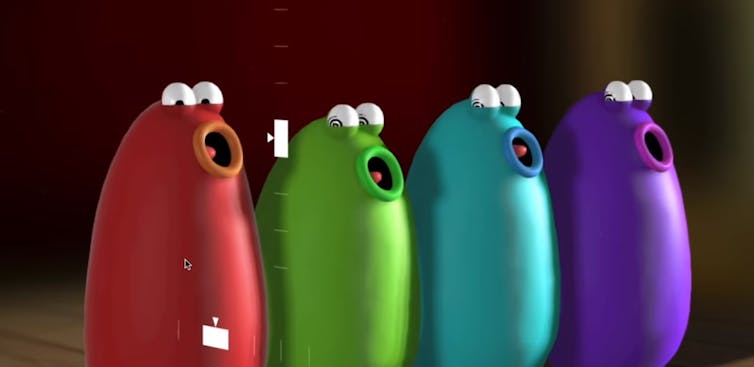Teaching music online in the pandemic has yielded creative surprises
January 21, 2022
Share

Learning to make music . Whether teaching how to play a musical instrument, or how to sing, teachers rely on learners‚Äô physical cues to help them progress ‚ÄĒ cues that are often obscured either by watching someone on a screen or listening through a microphone. As a music educator, I‚Äôd hazard that few school music teachers would opt to teach their students remotely.
 However, as many teachers and students have , music lessons during the pandemic have unearthed some pleasant surprises.
However, as many teachers and students have , music lessons during the pandemic have unearthed some pleasant surprises.
Going online has forced music educators to adapt existing ideas, or adopt existing technology, to discover, invent and share ways to reach students to keep music education alive.
Instrument-free music
During the pandemic, most school-based music teachers have faced the challenge that elementary students don’t have access to instruments at home. This often leaves online tools as the default. As school budgets are always stretched, it’s important for programs to be very inexpensive or preferably free.
At the elementary level, students can enjoy and learn from , where students can explore beatboxing, combining rhythms and sound effects to create unique pieces. Beatboxing musicians who create inspired this tool’s development.
Or teachers can introduce students to choral exploration in , a ‚Äú,‚ÄĚ developed by Google and AI artist David Li. , students manipulate four operatic blobs ‚ÄĒ a soprano, alto, tenor and bass quartet ‚ÄĒ and can have them sing a variety of pieces on global stages. Students can ‚Äútake the blobs on tour‚ÄĚ where they might sing , or a piece by composer in Paris.
On various platforms, students are able to share their creations live with teachers and classmates. I’ve found that when we introduce technology to students, they often take it in unexpected directions. One student I was teaching set up a rhythm on Incredibox and left that window open and playing to accompany a Blob Opera set: not an obvious musical pairing but a wonderfully creative one.
Learning from home with instruments
Even before the pandemic, some music researchers were interested in helping educators overcome hurdles with . However, singing and playing instruments online comes with its own set of technological issues, the most prominent of which is time lag ‚ÄĒ what some of my students refer to as ‚Äúglitchiness.‚ÄĚ
However, research conducted during the pandemic suggests that teaching students how to play instruments online can offer music teachers the chance to .
For students who have access to instruments at home, music teachers can use a flexible accompaniment app like . Without altering pitch (a critical capability), students can change playback speeds, manipulate the nature of accompaniment they hear, activate a metronome and even click on individual notes in a score to show the fingering and sound of the note for specific instruments.
This program costs money, but schools are able to purchase site licenses, thus making the resource accessible to more students.
Sound exploration
≥“ī«ī«≤ĶĪŰĪū‚Äôs suite offers learning for K-8 students. Younger children , or teachers and students can explore melody, harmony, form, duration, rhythm, timbre and tempo , save projects and submit them for assessment.
At the secondary level, teachers can encourage students to explore and collaborate on , a program akin to Apple‚Äôs Garageband. Students can compose pieces using standard western notation on the web-based ‚ÄĒ especially accessible because it requires no downloads or sharing of personal information.
Some online offerings promote healthy movement at home. , hosts professional development for teachers and .
Other teachers have posted , based on techniques from an approach to teaching rhythmic movement, listening and embodied music intuition known as and subsequent work by .
Making music education more inclusive
Aside from making music at home accessible for many students, online learning that focuses more on pop music, electronica and rhythm-heavy musics tends to shift the curricular emphasis away from predominantly western art music like ‚Äúclassical‚ÄĚ genres.
Music researcher Margaret Walker examines how . Walker is one of many music educators promoting music education that reflects the cultural diversity of learners. Music education researcher found that students who have more choice about their own repertoires are more successful and stay with music longer.
Revising music curricula to be more inclusive may involve both introducing new forms of music, but also repositioning canonical artists like Mozart and Bach within a broader musical context to allow entry and success for more learners.
Learning about music
Music curriculum calls not just for making music but also learning about music. Online read alouds, ‚ÄĒ narrated stories accompanied with music ‚ÄĒ existed before the pandemic but likely became even more useful in remote contexts. Favourites of my students include Sergei Prokofiev‚Äôs 1936 composition and the 2015 children‚Äôs book by Troy Andrews.
Music educators and students also benefit from the isolation-inspired composite style videos such as the especially when students cannot currently attend live performances.
For younger children, , , launched a children’s The series sees Harmon, a fuzzy dog puppet, isolated on a spaceship. Harmon’s limited social contact happens via . The first episode has over 11,000 views on YouTube. When I interviewed Mitchell, he said he has received many letters from children concerned for Harmon’s safe return to Earth.
No one wants remote music education to become the norm for most students. But the creative minds who have made it feasible, fun and often productive have given us unexpected gifts and welcome strains of beauty amidst global noise.![]()
______________________________________________
, Lecturer in Musicology, Dan School of Drama & Music,
This article is republished from under a Creative Commons license. Read the .